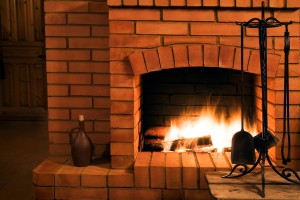 Chimneys are fairly simple structures when compared to other types of devices we use to stay comfortable. They use the laws of physics to vent smoke outside of the home, and there are not many moving parts aside from, perhaps, a damper you open and shut as needed.
Chimneys are fairly simple structures when compared to other types of devices we use to stay comfortable. They use the laws of physics to vent smoke outside of the home, and there are not many moving parts aside from, perhaps, a damper you open and shut as needed.
It’s precisely this simplicity, however, that allows for so many misconceptions about fireplaces and chimneys. Many people skip the maintenance necessary to keep a home safe, or decide to try it their own, and this is a huge risk. Below, we break down 4 myths about chimneys that we hear all too often, so that you have the information necessary to keep your household safer.
#1: Chimneys don’t really need much maintenance
This is a myth we are always working to bust. Most people get routine maintenance for their cars from time to time. That’s because cars need new oil and have a bunch of complex components that may need care. A lot of people also get routine inspections for their gas heating equipment.
But for a chimney and fireplace—which is a relatively straightforward structure—a lot of people are willing to skip maintenance. However, there is a lot that can go wrong with a chimney. A buildup of sooty creosote in the chimney can start a fire, and even a small crack in the flue or masonry can quickly send it outdoors. Chimneys should be inspected and swept each and every year. This is true even if you don’t use your fireplace often.
#2: I can clean the chimney myself
Not so fast. You may be able to get your hands on brushes and other tools that claim to keep a chimney clean. However, without the proper know-how and training, you cannot do a thorough job of keeping a chimney safe,
Instructions on the internet don’t equate to a trained eye. You may be able to get some creosote out of the chimney but you miss the opportunity to have someone with experience really check out the lining of the structure and look for any gaps that could increase the risk of a fire. Plus, you’re likely to make a mess, and could put your own health at risk if you don’t know the right measures of protection to use.
#3: I have a metal chimney liner, so my chimney is no longer at risk
A masonry chimney without a liner can be quite dangerous. It is much more likely to develop cracks and lead to fire than a metal flue. Plus, it may not be properly sized for the fireplace, which adds additional safety and efficiency risks.
That’s why we recommend installing a metal chimney liner in an older masonry chimney. However, that doesn’t make it completely safe. A metal chimney liner can still build up creosote, and there could be other types of blockage that keep you unsafe.
#4: Household items are safe to burn in small amounts
We know that it may seem easy to throw wrapping paper into the fire after a holiday party or to tear up some newspaper inserts and toss them in, but many household items like this are very unsafe for the fireplace. Colored papers, pizza boxes, stained woods, and more have chemicals that can create toxic fumes, which you want to avoid at all costs.
Contact 2nd Generation Chimneys, Inc. for chimney and fireplace services in St. Paul, MN.
